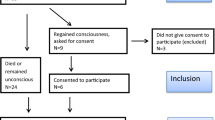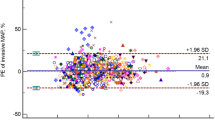Abstract
Objective
To determine the correlation of non-invasive blood pressure obtained by auscultatory and oscillometric methods, with invasive blood pressure in critically ill children.
Methods
We compared invasive with auscultatory and oscillometric blood pressures using paired t-test, Pearson’s correlation coefficient and Bland-Altman plot in 50 children (age 1-12 y) admitted in Pediatric intensive care unit.
Results
Systolic, diastolic, and mean arterial pressures of invasive methods significantly correlated with auscultatory and oscillometric methods (P<0.001). Auscultatory and oscillometric measurements under-estimated systolic arterial pressures [mean (SD) difference 5.4 (12.2) mmHg and 6.3 (14.0) mmHg, respectively; P<0.001] and overestimated diastolic arterial pressures [-4.1 (5.8) mmHg and -3.6 (7.2) mmHg; P<0.001] compared to invasive blood pressure.
Conclusion
Mean arterial pressure obtained by NIBP measurement is more closer than systolic or diastolic pressures, when compared with invasive blood pressure measurement.
Similar content being viewed by others
References
Parati G, Bilo G, Mancia G. Blood pressure measurement in research and in clinical practice: recent evidence. Curr Opin Nephrol Hypertens. 2004;13:343–57.
Tholl U, Forstner K, Anlauf M. Measuring blood pressure: Pitfalls and recommendations. Nephrol Dial Transplant. 2004;19:766–70.
Chatterjee A, DePriest K, Blair R, Bowton D, Chin R. Results of a survey of blood pressure monitoring by intensivists in critically ill patients: A preliminary study. Crit Care Med. 2010;38:2335–8.
Bernstein D. Evaluation of the Cardiovascular System. In: Kliegman RM, Stanton BF, Geme JW, Schor NF, editors. Nelson Text Book of Pediatrics. 20th ed. Philadelphia: Elsevier; 2016. p. 2164.
Bland JM, Altman D. Statistical methods for assessing agreement between two methods of clinical measurement. Lancet. 1986;327:307–10.
Schroeder B, Barbeito A, Yosef SB, Mark JB. Cardiovascular Monitoring. In: Miller RD, editor. Miller’s Anesthesia. 8th ed. Philadelphia: Elsevier Saunders; 2015. p. 1347–9.
Hager H, Mandadi G, Pulley D, Eagon JC, Mascha E, Nutter B, Kurz A. A comparison of noninvasive blood pressure measurement on the wrist with invasive arterial blood pressure monitoring in patients undergoing bariatric surgery. Obes Surg. 2009;19:717–24.
Pickering TG, Hall JE, Appel LJ, Falkner BE, Graves J, Hill MN, et al. Recommendations for Blood Pressure Measurement in Humans and Experimental Animals Part 1: Blood Pressure Measurement in Humans: A Statement for Professionals from the subcommittee of professional and Public Education of the American Heart Association Council on High Blood Pressure Research. Hypertension. 2005;45:142–61.
Pickering TG. What will replace the mercury sphygmomanometer? Blood Press Monit. 2003;8:23–5.
Razminia M, Trivedi A, Molnar J, Elbzour M, Guerrero M, Salem Y, et al. Validation of a new formula for mean arterial pressure calculation: The new formula is superior to the standard formula. Catheter Cardiovasc Interv. 2004;63:419–25.
Joffe R, Duff J, Guerra GG, Pugh J, Joffe AR. The accuracy of blood pressure measured by arterial line and noninvasive cuff in critically ill children. Crit Care. 2016;20:1.
Holt TR, Withington DE, Mitchell E. Which pressure to believe? A comparison of direct arterial with indirect blood pressure measurement techniques in the pediatric intensive care unit. Pediatr Crit Care Med. 2011;12:e391–4.
Ribezzo S, Spina E, Di Bartolomeo S, Sanson G. Noninvasive techniques for blood pressure measurement are not a reliable alternative to direct measurement: a randomized crossover trial in ICU. Scientific World J. 2014;353628.
Davis RF. Clinical comparison of automated auscultatory and oscillometric and catheter-transducer measurements of arterial pressure. J Clin Monit. 1985;1:114–9.
Nelson RM, Stebor AD, Groh CM, Timoney PM, Theobald KS, Friedman BA. Determination of accuracy in neonates for non-invasive blood pressure device using an improved algorithm. Blood Press Monit. 2002;7:123–9.
Author information
Authors and Affiliations
Corresponding author
Rights and permissions
About this article
Cite this article
Krishna, B.V., Das, S. & Sen, S. Correlation Between Blood Pressure Measurement by Non-invasive and Invasive Methods in Critically-ill Children. Indian Pediatr 55, 297–300 (2018). https://doi.org/10.1007/s13312-018-1271-y
Received:
Revised:
Accepted:
Published:
Issue Date:
DOI: https://doi.org/10.1007/s13312-018-1271-y




